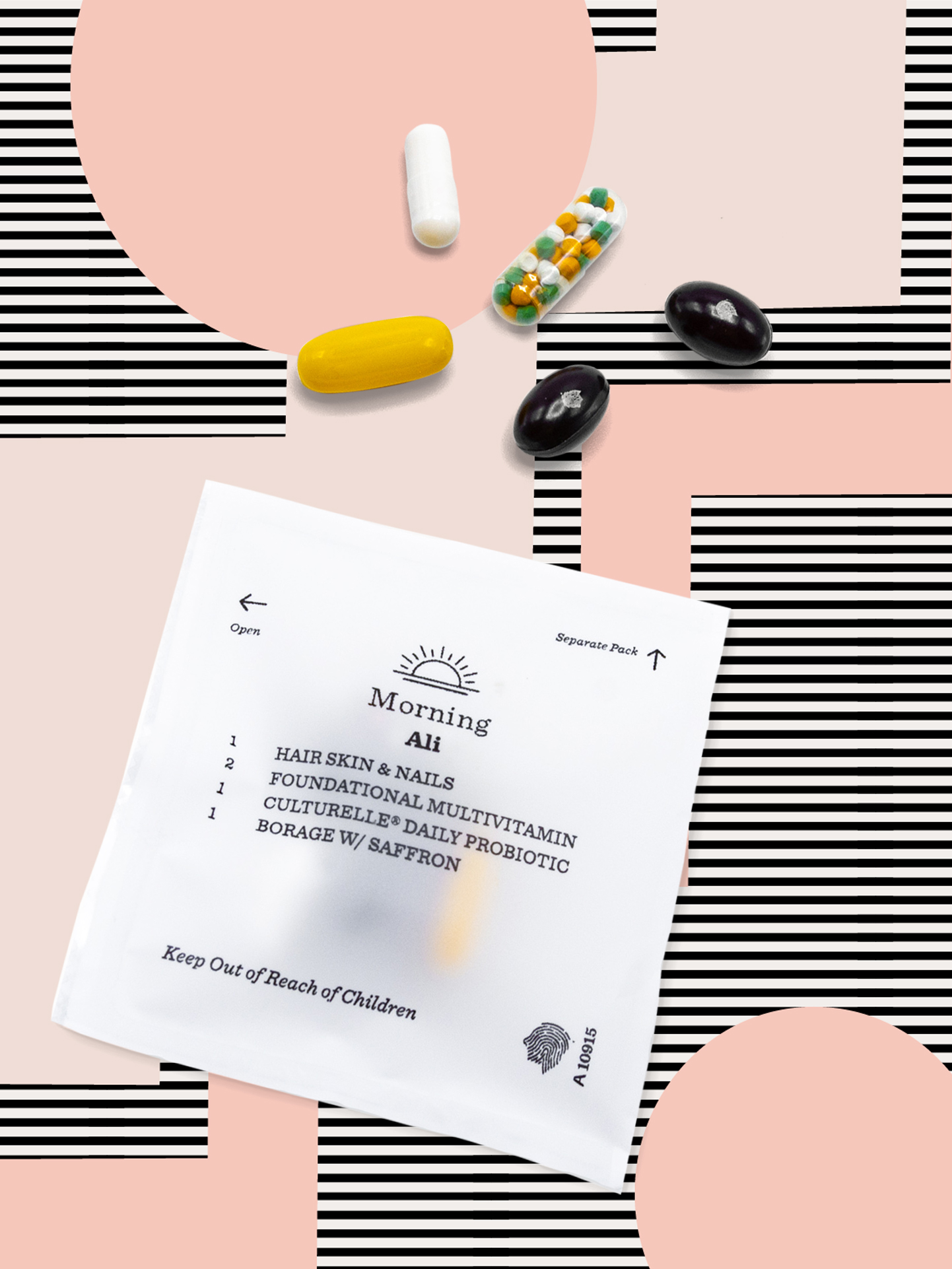We may earn revenue from the products available on this page and participate in affiliate programs.
Millennials are no strangers to supplements. Over the past few years, ingredients such as ashwagandha and tocotrienols have at least somewhat entered the conversational lexicon, and companies like Ritual and Care/Of have made vitamins cool. As an entire generation has embraced capital-W Wellness, it’s gotten way easier—and way more acceptable—to embrace the things that simplify getting all your nutrients, day in and day out.
Vitamins have become Instagram-friendly recently, but now they’re undergoing an even more thorough makeover. Such new companies as Rootine, GEM, and Persona are reinventing what nutritional supplements look like. Plot twist: They’re not always pills.
Rootine’s vitamins come in tiny, single-serve packets of microbeads, while GEM’s are bite-size superfood squares. Persona is the most traditional of the bunch, boasting an array of pills in custom packs (admittedly, not unlike Care/Of), but offers a few micro-tablet options in addition to personalized packs created with medical history and habits in mind.
But why exactly are vitamins in need of reinvention in the first place?
Pills just don’t work for everyone

Sometimes pills really are just hard to swallow—in the metaphorical and literal sense. “Approximately 40 percent of people cannot take standard large pills,” says Rachel Soper Sanders, cofounder of Rootine. This is why the brand doesn’t offer traditional pills but rather tiny beads that do, admittedly, look like sprinkles. “Microbeads are an easier form of vitamin to take,” she explains.
Some vitamins combine traditional pills with microbead technology, too, so you can choose to either swallow a pill or sprinkle the beads into your food or drink. As Tamara Bernadot, cofounder and chief nutrition officer of Persona, explains, “This increases compliance: the ability for consumers to take their vitamins and supplements every day.” Consider the allure of Flintstone vitamins and vitamin-C gummies to a child—a different dosage experience can make something that feels like a pain actually enjoyable. These brands are simply creating a more nutritious, more adult version of that experience.
They can also be easier to process

The amount of time it takes for pills to be absorbed into your bloodstream widely varies anywhere from 15 minutes to several hours, based on what kind of pill it is. Microbeads, however, absorb at a more reliable pace. “Slow-release microbeads deliver a customized dosage of vitamins into your bloodstream throughout the day, which is how your body naturally likes to absorb nutrients, in the same way it would from food,” says Sanders. “Also, by separating nutrients into individual microbeads, Rootine’s vitamins are easier to absorb than standard multivitamins.”
Ever take a pill on an empty stomach and instantly feel ill? There’s a reason for that—and it’s the same reason why your body might not be processing supplements as well as you’d hope. “In order to get vitamins and minerals shoved into a tiny pill or capsule, you have to isolate the other essential co-nutrients and superfood compounds found in real foods. These complementary bioactive compounds help the essential vitamins and minerals absorb effectively in your body,” GEM founder Sara Cullen says. “That’s why we are often told to get our vitamins and minerals from food; with real food, you efficiently metabolize nutrients without the nausea.” And that’s why GEM supplements aren’t pills—they’re nutrient-rich edibles.
“One size fits all” is never really a one size fits all.

Yes, a multivitamin is seemingly the easiest way you can fill in any nutritional gaps you might have. But the way it fills those gaps isn’t always better than having the gaps in the first place. “So many multivitamins have unnecessary megadoses of everything. Simply put, you don’t need 1,000 percent of anything,” Cullen says. “In fact, overloading your body with vitamins can be harmful.”
For GEM, the solution is superfood driven, with ingredients like chlorella, algae, and spirulina offering up plenty of vitamins in an easy-to-digest, environmentally sustainable way. But according to Bernadot, you don’t necessarily have to rule out more traditional vitamins, as long as they’re prescribed in a more customized manner.
“Personalized vitamins reduce the risk of nutrient deficiencies while preventing a buildup of excess vitamins in your body. By turning to a personalized nutrition program, your health-care practitioner can help you uncover ways to make your diet and supplement program align,” says Bernadot. In addition, you should always be mindful of how supplements and prescription medications might interact. “The most important scientific factors to consider when selecting personal vitamins is drug-nutrient interactions, or DNIs. When we prepare personalized nutrition models for our consumers, we cross-reference more than 850 prescription medications to avoid risky drug-nutrient interactions.”
While Persona helps people find their mix of vitamins through an extensive questionnaire (which takes into consideration general lifestyle, habits, and medical history), Rootine opts for genetic testing to best assess a patient’s needs. “DNA plays a large role in determining which nutrients are the harmful ones and which are helpful,” Sanders explains “For instance, for certain individuals with a genetic variation on the HFE gene, taking extra iron supplements can be similar to poisoning your body over time and may even lead to death. And for individuals with a genetic variation on the NQO1 gene, Co-Enzyme Q10 could be completely useless, because their bodies cannot activate the nutrient.”
Now there are plenty of resources to find the right vitamins for you—but when in doubt, always consult your doctor first.
See more wellness: This New Vitamin Promises Less Anxiety and Healthier, Shinier Hair, But Does It Work? Take a Bath: The Case for Grown-Up Tub Time Bar None: Shampoo’s Latest Form Is Perfect for Summer Travel
